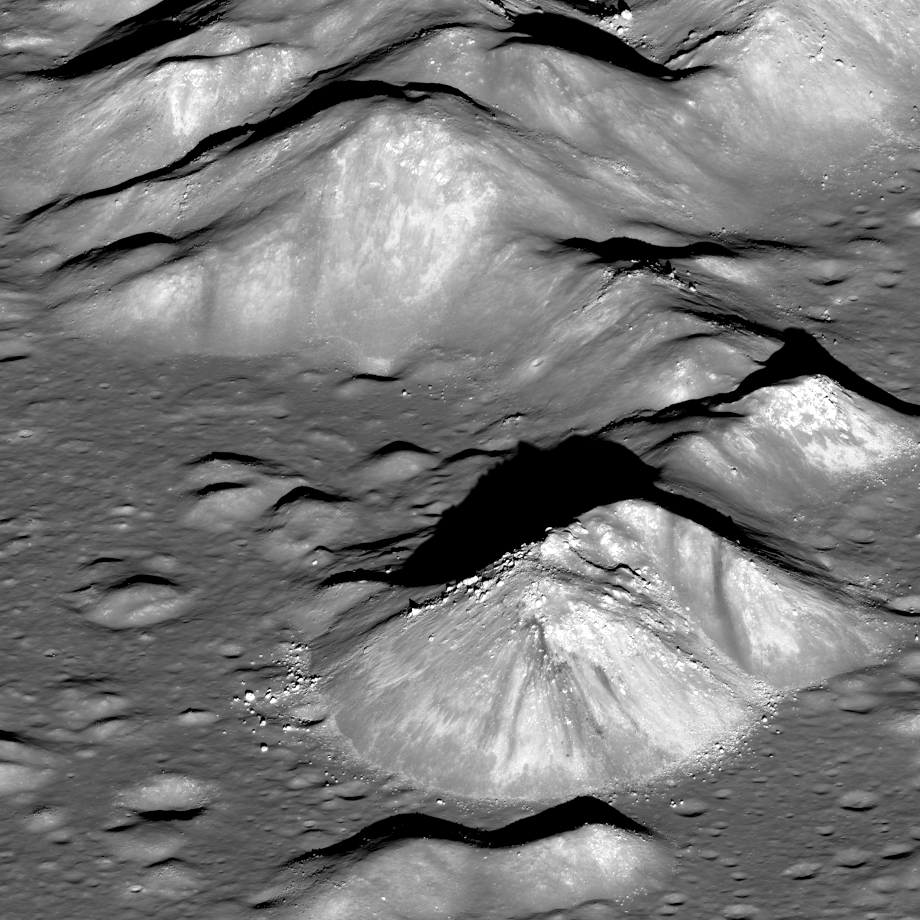 |
| West-to-east view of the Copernicus crater central peak complex. Detail from LROC Narrow Angle Camera (NAC) mosaic of M19666538lL & R, LRO orbit 13,981, July 11, 2012; general resolution is 4 meters. [NASA/GSFC/Arizona State University]. |
Mark Robinson
Principal Investigator
Lunar Reconnaissance Orbiter Camera
Arizona State University
LROC captured this spectacular view of the heart of Copernicus crater just before (local) sunset, July, 11 2012. Compare it to the reverse view point snapped from the East near local sunrise, May 5.
LROC can only be slewed large angles while looking away from the Sun, otherwise its radiators are exposed to the hot Moon and the LROC Wide Angle Camera (WAC) optics are exposed to the Sun. So back-to-back obliques are not possible on the same day.
Back to Copernicus, what are those dark streaks we see on the peak? In the comparison image above, and if you skip back to the earlier post that shows the other side, that dark streak is seen on both sides of the central peak, showing that it is three dimensional within the peak. Might it be a dark rock intruded as a dike into the light colored crystalline bedrock that was brought up from beneath the deepest part of the transient cavity in the Copernicus target? Or is it simply a dark rock that is eroding and slumping down the sides of the peak?
Because of their state of preservation (despite being nearly a billion years old) and the identification of scientifically interesting mineralogy from remote sensing spectroscopy, the central peaks of Copernicus have long been coveted by lunar explorers as a prime location for a mission, including sample return. In fact, Copernicus was considered as an Apollo landing site, and was recently proposed as a target for a robotic rover within the Discovery program. To sample the peak you wouldn't need to scale the slopes - in the top image you can see many rocks and boulders that have rolled down from the summit, lying on the relatively flat floor waiting to be picked up.
When and how will we first visit this fascinating, geologically rich area? Imagine the view astronauts will have as they descend to the floor and then step out at the base of this peak. Explore the full LROC NAC oblique mosaic release, HERE.
Previous LROC Featured Images highlighting Copernicus:
Copernicus - Looking Straight Down (June 28, 2012)
Principal Investigator
Lunar Reconnaissance Orbiter Camera
Arizona State University
LROC captured this spectacular view of the heart of Copernicus crater just before (local) sunset, July, 11 2012. Compare it to the reverse view point snapped from the East near local sunrise, May 5.
LROC can only be slewed large angles while looking away from the Sun, otherwise its radiators are exposed to the hot Moon and the LROC Wide Angle Camera (WAC) optics are exposed to the Sun. So back-to-back obliques are not possible on the same day.
 |
| Central peak with bouldery outcrops and streak seen from the east (top), and the west (bottom) [NASA/GSFC/Arizona State University]. |
 |
| Reduced resolution view of the entire NAC view of Copernicus crater. View 1600 pixel-wide rendition, HERE [NASA/GSFC/Arizona State University]. |
Because of their state of preservation (despite being nearly a billion years old) and the identification of scientifically interesting mineralogy from remote sensing spectroscopy, the central peaks of Copernicus have long been coveted by lunar explorers as a prime location for a mission, including sample return. In fact, Copernicus was considered as an Apollo landing site, and was recently proposed as a target for a robotic rover within the Discovery program. To sample the peak you wouldn't need to scale the slopes - in the top image you can see many rocks and boulders that have rolled down from the summit, lying on the relatively flat floor waiting to be picked up.
| Subsampled synoptic view of the central peak complex, field of view approximately 18 km across, the tallest peak rises more than 1300 meters above the floor. View the larger 1600 pixel-wide rendition, HERE [NASA/GSFC/Arizona State University]. |
When and how will we first visit this fascinating, geologically rich area? Imagine the view astronauts will have as they descend to the floor and then step out at the base of this peak. Explore the full LROC NAC oblique mosaic release, HERE.
Previous LROC Featured Images highlighting Copernicus:
Copernicus - Looking Straight Down (June 28, 2012)
New oblique of Copernicus central peaks (June 27, 2012)
Absolute Time
Central Peak of Copernicus Crater
Copernicus Crater and the Lunar Timescale
A Path Not Taken
Failed Skylights of Copernicus (January 24, 2012)
The smooth anomaly in Copernicus (September 29, 2010)
Copernicus (September 23, 2010)
New views of the Copernicus interior (May 5, 2010)
LOLA's Copernicus (April 23, 2010)
Absolute Time
Central Peak of Copernicus Crater
Copernicus Crater and the Lunar Timescale
A Path Not Taken
Failed Skylights of Copernicus (January 24, 2012)
The smooth anomaly in Copernicus (September 29, 2010)
Copernicus (September 23, 2010)
New views of the Copernicus interior (May 5, 2010)
LOLA's Copernicus (April 23, 2010)




No comments:
Post a Comment